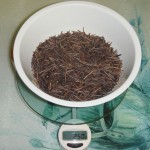by Cat, Nov 2007, updated Nov 2013 (brown rice photo, right, from Wikimedia Commons; wild rice photo, below, from Wikimedia Commons)
Pilaf is a savory side dish, in which the rice is cooked in a broth seasoned with vegetables, herbs, spices and/or dried fruit.
Wild rice does not come from the same plant as traditional (Asian) rice, and is technically not a cereal grain. Wild rice was first cultivated by native peoples in North America, where it was grown in marshes of the northern great plains. It is rich in protein, high in B-complex vitamins, magnesium, potassium, phosphorus and zinc. It is relatively low in fat, so be sure to add plenty of butter.
It takes longer to cook than traditional rice, and also benefits from soaking in whey for at least 7 hours before cooking. In this recipe, it is pre-cooked first; the brown rice is added later. Another option would be to use white rice, but that requires even less cooking time – 15 minutes or so – so you would add it to the pot later.
- See also: 1. Steamed Brown Rice; 2. Steamed Wild Rice; 3. Sides & Condiments Menu for more wild rice and brown rice recipes.
Wild and Brown Rice Pilaf
This recipe, adapted from The New Vegetarian Epicure by Anna Thomas, also makes a lot of pilaf (8 servings).
The wild rice needs a longer cooking time than the brown rice, so it is pre-cooked first. If you wish, instead of pre-cooking it (steps 1-2), you can pre-soak it; see Note at beginning of the method.
Ingredients:
- 1 cup wild rice
- filtered water
- 1½ Tbsp olive oil
- 1 onion, finely chopped
- pinch Unrefined sea salt, or to taste
- ¼ cup dried currants or chopped dried apples (optional)
- 1¼ cup long grain brown rice (such as Basmati)
- 3 cups homemade Vegetable Broth or Chicken Stock
- 2¼ cups water
Optional herbs:
- fresh thyme, marjoram, savory, or oregano
Equipment
- heavy 2 or 3 quart saucepan, or flameproof casserole
- steel simmer plate
Method:
NOTE: If you pre-soaked your rice for at least 7 hours, skip steps 1 – 2. Drain, rinse the wild rice and then pick up this recipe at step 3. See Steamed Wild Rice (Pre-soak method) for more detail.
If using white rice, don’t add it at step 3 (when brown rice is added), but rather after the wild rice, etc. have cooked for about 40 minutes in step 4. Monitor the liquid level about 10 minutes after adding the white rice, and add more as needed.
- Wash wild rice thoroughly and place in large saucepan. Cover with cold, filtered water and bring to a boil over medium heat. Drain.
- Repeat this procedure once more. Many of the seeds will have cracked open slightly. Set aside.
- Meanwhile, warm olive oil in a medium-sized saute pan, or flameproof casserole. Add the chopped onion, pinch salt and cook over medium heat, stirring often, until the onion is soft and translucent. Add the optional currants (or apples), pre-cooked wild rice, and the (uncooked) brown rice, and stir them with the onions for a couple minutes.
- Add the broth and water; bring the liquid to a simmer. Lower the heat to lowest possible setting and cover the pan tightly. Use a steel simmer plate if your lowest heat is to high for steaming. Steam the rice mixture for 55 minutes, then turn off the heat and let it stand, without lifting the lid, for another 5 minutes. Fluff with a fork before serving
Assembly or Serving Suggestions
- Garnish rice in serving bowl with sprigs of thyme or parsley .
- Serve with veal, chicken or pork made with a creamy or cheesy sauce.
- Serve with prime rib or other roast of beef, lamb, or venison and a red wine reduction of pan juices.
- Line a serving bowl with thin slices of apple, then fill with your favorite cooked wild rice.
References:
- Nourishing Traditions, by Sally Fallon with Mary G. Enig
- The New Vegetarian Epicure, by Anna Thomas


